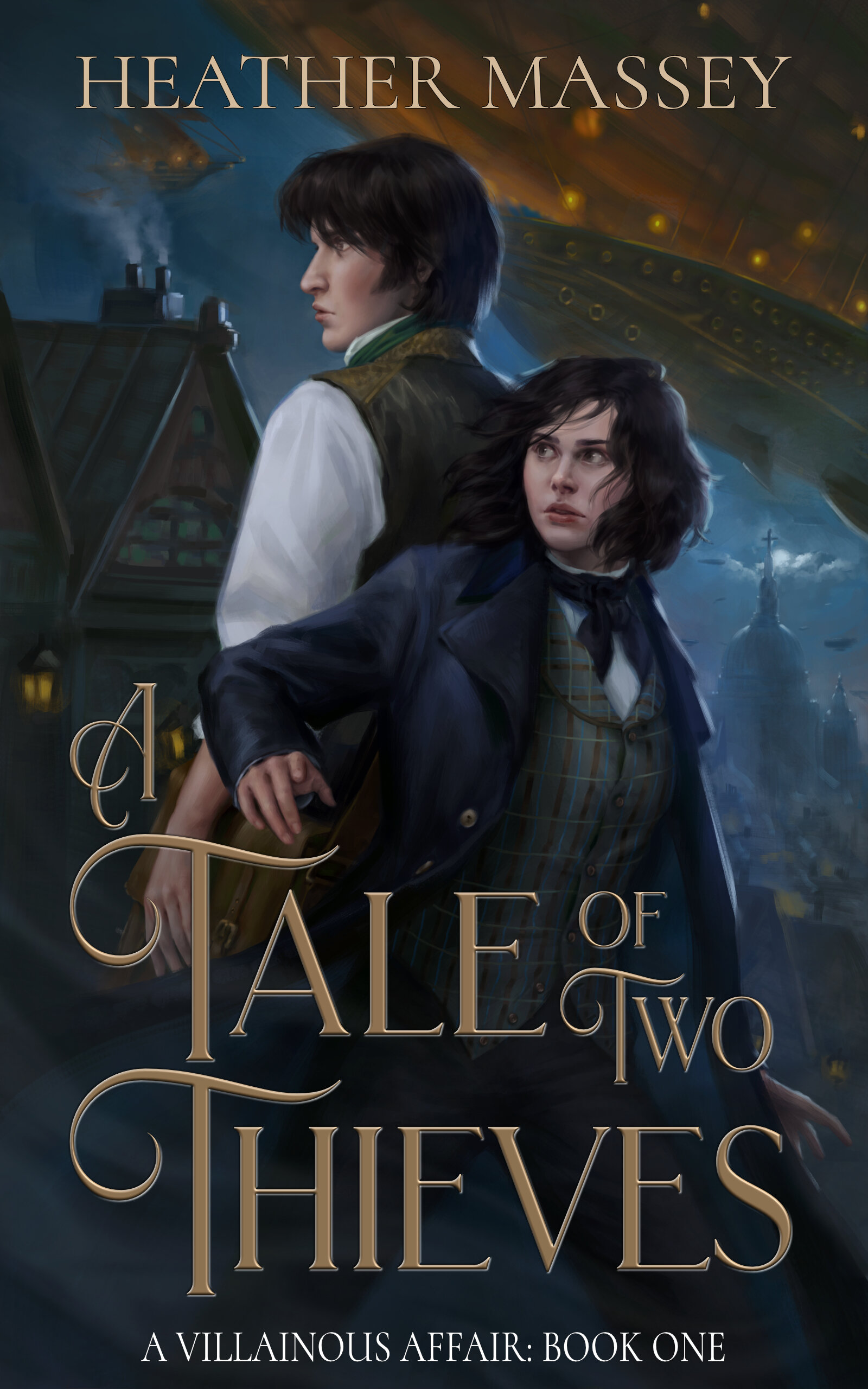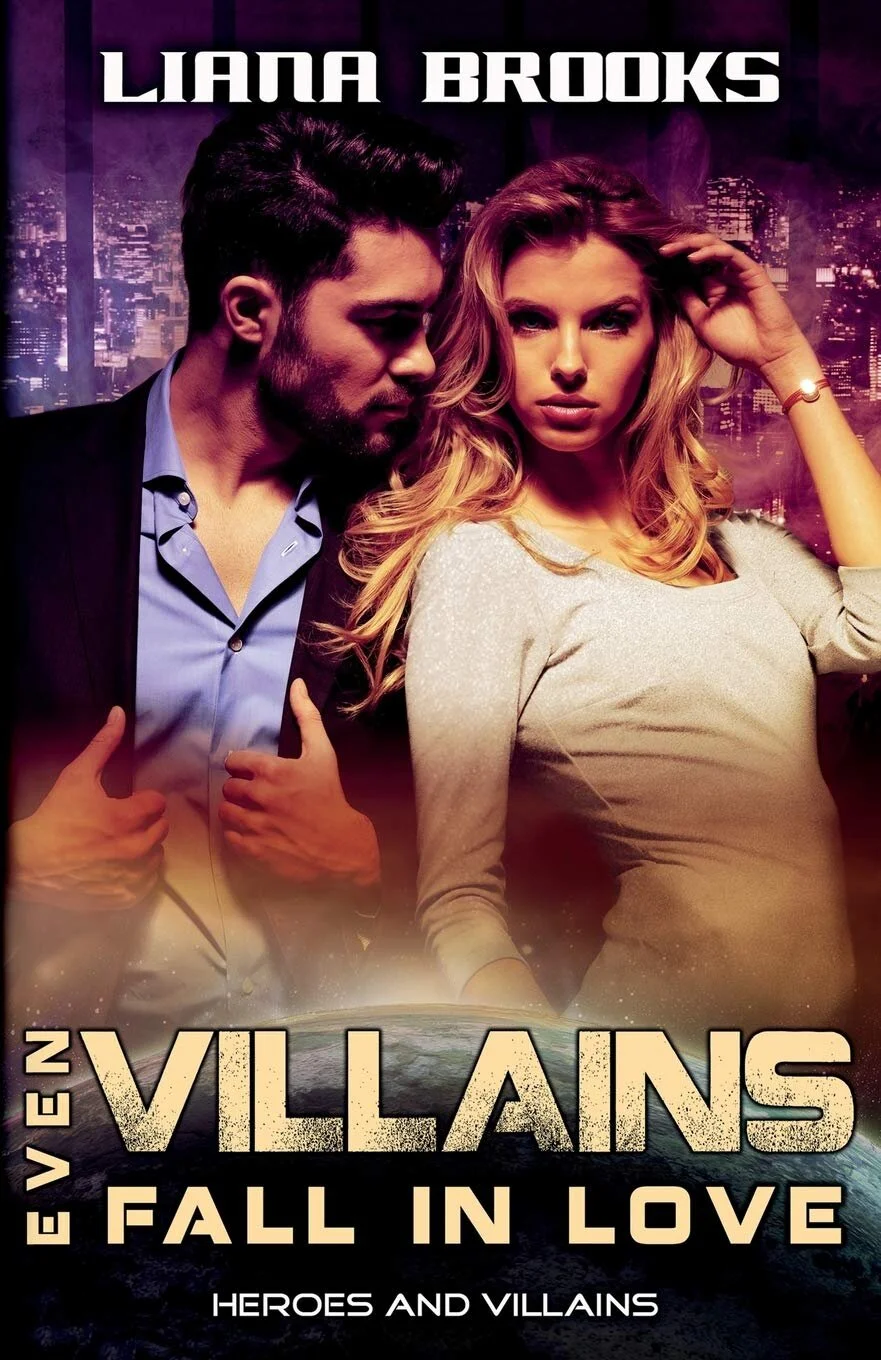The Unique Appeal of Villain Couple Romances
Cover for Heather Massey’s A Tale of Two Thieves, book one of the A Villainous Affair quartet. A fugitive white m/f couple dressed in Victorian suits stands back-to-back in a moonlit Victorian London. They look off into the distance, sensing danger. The man carries a satchel. Airships fly above in the cloudy sky. The dome of St Paul’s Cathedral is in the background. Illustration by Elizabeth Peiró.
Villain couple romances appear in many genre stories. Whether a subplot or the main focus, they’ve become even more popular ever since science fiction and fantasy tales have cemented their rightful place in mainstream pop culture. You can discover villain couples in movies, TV, books, anime, fanfiction, and comics.
Especially fanfiction! Fanfic writers practically wrote the book on villain romances because they frequently dare to explore not only unusual pairings but also ones that many consider taboo. Depictions of fanfiction villain couples range from light and fluffy to dark and intense.
Science fiction and fantasy villain romantic couples have also found their way into mainstream stories, albeit at a lower rate than fanfiction ones. This article will focus on full-fledged villain romances as opposed to one-sided villainous crushes, villain/heroine romances, villain love interests, or stories where heroes fall in love with the villain. The former is about mutual feelings of romantic love while the latter is often one-sided or takes the form of unrequited love (don’t get me wrong—the unrequited love trope is incredibly riveting!).
Why we love the idea of villains falling in love
Villain romances are often born of a mutual goal: a villain romance develops when one villain finds common ground with another villain who shares their vision (for world domination or some other dastardly plan). It’s awfully exciting when a villain discovers someone with whom they can share their passion—albeit a passion for mayhem, theft, and other nefarious deeds. Two villains + sex + romance + vanquishing the hero = what’s not to love?!
Supervillain Casanova Frankenstein and his lover, Dr. Anabel Leek from the movie Mystery Men. © Universal Pictures
An example of this aspect can be found in the movie Mystery Men. Supervillain Casanova Frankenstein (Geoffrey Rush) and his “psychiatrist” Dr. Anabel Leek join forces to spring him from Champion City’s psychiatric facility. Based on the knowing glances the two characters share and especially the fact that they cohabitate after Casanova is free, it’s clear they are partners in crime as well as romance.
The 20 Most Menacing Supervillain Couples
When a villain falls in love, it often means a revealing of the antagonist’s softer side. The contrast between a villain’s malicious side and their lovey-dovey side is often striking as well as entertaining. Many people love watching a villain battle the superheroes in one scene and then in the next one bake cupcakes—perhaps lovingly frosted with sweet buttercream—for their criminally-minded honey bunny. It’s even better if the cupcake baker subverts gender stereotypes by being masculine presenting.
Scarlet and Herb Overkill from the Minions movie are two villains who have fallen wildly in love and aren’t afraid to show it. They hug, kiss, and caress each other on a regular basis—even making out in front of other people—all of which indicate a healthy and active romantic and sexual relationship. When they’re not feeling each other up, they’re running their criminal empire and planning attacks against the Queen of England.
Another reason we enjoy villain couples falling in love: it’s reassuring to learn that a villain isn’t all bad. If nothing else, they have the ability to nurture and support at least one other person and love them unconditionally. Love and romance can keep a villain somewhat tethered to humanity, even if their love is the only pure thing about them. Finally, villain romances imply that love might be able to redeem a villain—a situation that many fans find relatable.
Lana Lang and Lex Luthor lean forward to kiss each other during an episode of Smallville. © Warner Bros.
After the TV show Smallville closed the door on Lana Lang and Clark Kent’s romance, Lana’s friendship with future criminal mastermind Lex Luthor turns into a romantic bond—even a dark romance, given Lex’s many dark secrets.
Okay, so technically, Lana Lang isn’t a villain. But I’d argue she evolves into one the more deeply involved she becomes with Lex. After all, Lex really dug it when she did a dirty deed to protect him! No one ever did that for him before, he subsequently proclaimed.
Most of Smallville’s viewers understand that Lex is destined to become Superman’s greatest nemesis, so watching him fall hopelessly in love with the (usually) pure-hearted Lana gives us hope that he might reject the evil forces determined to destroy the remaining slivers of his moral compass.
23 Supervillains Who Fell in Love
Get your villain couple fix in villain romance books
Cover for author Lana Brooks’ Even Villains Fall in Love. A white couple leans against each other in sensual poses. They stand against a nighttime city landscape.
Villain romance novels (meaning, those that follow the romance genre convention of a Happily Ever After) seem to be few and far between—and probably with good reason. Most romance readers prefer to read about couples who are fundamentally good, not evil.
But is that a true scarcity issue, or is it because villain romances are masquerading as something else? Are they, in fact, more common than the genre’s story labels would indicate?
Ironically, hundreds, if not thousands, of romance books in various subgenres—some of them dark romances—feature main characters who are assassins, rapists, white supremacists, enslavers, kidnappers, or mobsters. Even if the other main character isn’t a criminal, does falling in love with one make the other protagonist part of a villainous couple? Part of that depends on whether the criminal main character rejects a life of crime by the story’s end.
What about cis white duke characters in historical romances? Considering much of their wealth came from the exploitation of enslaved Black people and Britain’s colonization of countries like India, do they truly fit the definition of heroes, or is “villain” a more accurate framing? It’s a thorny issue, to be sure.
Many such romances feature a redemption arc for the criminal/villain character, although there are definitely some characters who shouldn’t be included in a romance, let alone redeemed. Why? Well, such characters are in the criminal business of denying humanity to other people—usually marginalized people. That’s not redeemable. Any book that claims otherwise is simply trying to launder the reputation of people who lack a moral compass and engage in heinous deeds such as genocide.
The villain definition at play also impacts how readers perceive the characters. Criminals are people who break laws within a limited scope for usually short-term gain, whereas villains break laws to fulfill a master plan—often domination of some kind that can take months or years to achieve. The word “villain” itself is strongly associated with the superhero genre, so that’s another reason many authors with criminal characters might not apply this label to their romances.
Author Lana Brooks wrote a romance called Even Villains Fall in Love, but I haven’t seen others that code the characters as villains quite so overtly.
Five Supervillain Couples Who Wreaked Havoc in Their Comicbook Universe
Different types of villains in villain couple romances
Cover for Heather Massey’s Battle Royale, book four of the A Villainous Affair quartet. A young white man and a young white woman in a clinch make loving eye contact as they stand in front of a Victorian-era Buckingham Palace. They wear fancy evening clothes. Illustration by Elizabeth Peiró.
The types of villains in SFF villain couple romances include evil characters who harm other people for malicious purposes, misunderstood villains, angsty villains, cartoon-lite villains, and marginalized characters framed as villains—meaning their villainous nature is questionable depending on who’s doing the framing. Basically, there’s a villain romance couple for all tastes in various types of mediums.
In my steampunk romance saga, A Villainous Affair, a villain couple falls in love while plotting to conquer England. Ruby is a grumpy bodyguard who protects Nathan, a sunshine fugitive inventor whose aether devices give her amazing powers. But they don’t want to conquer England to enrich themselves or dominate others; rather, like Robin Hood, their goal is to redistribute the country’s wealth to help poor people.
On its surface, A Villainous Affair is a fantastical adventure about charming and fashionable Victorian-era supervillains battling tyranny, but the story also has deep thematical roots. It engages with and interrogates the characters’ villainous deeds, natures, and white privilege while also exploring society’s framing of marginalized groups as evil/criminal/worthless.
Often, society villainizes women—all kinds of women—just for being women, usually for the purpose of controlling them. Thus, the tale’s central question asks: is Ruby Darling really a villain for wanting to wield the power of the Crown to eliminate poverty, or has the dominant group framed her as one because the cis men in power feel threatened by the fact that she has ambition, agency, and advocates for social justice?
A Villainous Affair also entertains with a villain couple romance that’s healthy as well as based on solidarity and trust—even as the pair embarks on a villainous mission.
Learn more about A Villainous Affair by reading the series’ primer
Read the description for the first book, A Tale of Two Thieves
Enjoy the first chapter of A Tale of Two Thieves






